|
Click here for the introduction to Articulated Steam Locomotives of the World.
Wiener classified Semi-Articulated Steam Locomotives in
two parts:
1. Semi-articulated Locomotives with a single engine and
two driven trucks eg Klien Lindner axle locomotives
2. Semi-articulated Locomotives with two engines and two
sets of driving wheels eg Mallets
A. Semi-articulated Locomotives with two engines and two sets of driving wheels
Semi-articulated Locomotives with two sets of Driving
Wheels, of which the rear only is mobile
Wiener records that 'A number of patents have been taken
out... ... none of them has been satisfactory'. The nearest thing to a
success would have been two rack and adhesion locomotives built by Esslingen
for the Chilean side of the Transandine Railway. An article by Ian Thompson
in Locomotives International #71 discusses these in some detail, see http://www.locomotivesinternational.co.uk.
Semi-articulated Locomotives with two sets of Driving
Wheels, of which the front only is mobile
Essentially this means Mallet locomotives and derivatives
of them - see http://en.wikipedia.org/wiki/Mallet_locomotive.
Anatole Mallet having invented the world's first successful compound steam
locomotive, in 1884 patented a design for an articulated compound system with a rigid chassis at the rear carrying two high-pressure cylinders plus two low-pressure ones mounted on an articulated front driving
truck. In his book on these locomotives - see Bibliography
- Durrant states "The Mallet must count as the most successful
articulated steam locomotive ever designed, for the quantities built (over
5,000) and period of construction (1887 - 1961) greatly exceed those of all
other types."
Unlike the Garratt which was associated primarily with one
company, Mallets were built by many companies and perhaps this is why there
is no one comprehensive web source - the subject is simply too vast. I saw my first Mallet in Indonesia in 1975. At the time I
was woefully ignorant of articulated locomotives in general, but since Java
would very soon become my favourite steam destination and it then had the largest
and most varied stock of such locomotives, it was not long before I was able
to put that to rights.
Amazingly some Mallets were built with flexible boilers,
for information see http://www.catskillarchive.com/rrextra/blwmal00.Html
(link dead by April 2015) and http://www.douglas-self.com/MUSEUM/LOCOLOCO/flexmallet/mallet.htm.
Like Durrant, I have had to be selective in my choice of cover. As with other
types, like my website as a whole, it concentrates on Asia, Africa, South
America and the more far flung parts of Europe, with particular reference to
today's survivors. This page summarises surviving Mallets which I know
about and those which enthusiasts have seen active in the last
40-50 years. The European section will most likely be woefully incomplete
(see http://www.malletlok.de/ link found broken on 27th October 2017), the
North American section even more so. If you can help put that to rights,
please get in touch. For a video which shows what happens a
Mallet slips watch this - http://www.youtube.com/watch?v=MNlZ5R3KRnA.
Africa
Eritrea
Were it not for the Eritrean Railway, this
section would be very, very short. I visited Eritrea in 2002, you can read
my extended report. This 950mm gauge Italian built line relied (and
still relies after restoration) almost entirely on Mallets. This is 442.55,
built by Ansaldo, on one of our charter trains:

The 442 class have piston valves on all
cylinders, the older 440 class had slide valves on the low pressure forward
cylinder. 440.008 has since been returned to service.
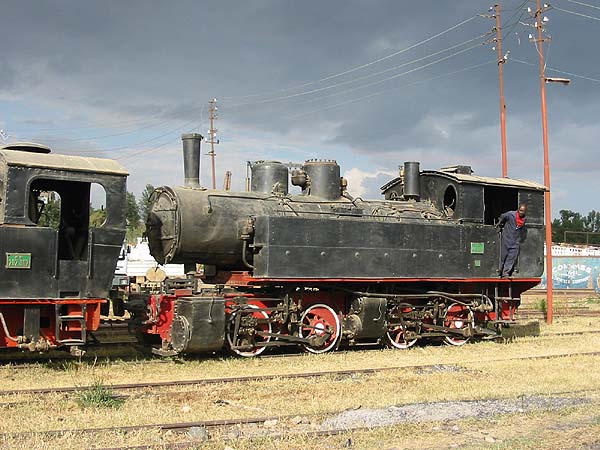

And if these beautiful creatures were not
reason enough to visit, then the scenery is stunning. I saw this view in
Charles Small's book many years ago and I never dreamed I would see it for
myself:

Madagascar
Like Eritrea, Madagascar was 'Mallet
country', Durrant's book suggested that about 50 were supplied here.
Charles Small took these pictures around 1955 by which time
dieselisation was complete. These pictures are all from our
Safari Steam CD-ROM:
40-824 (formerly 55) was bought second hand from the Rhätische Bahn in Switzerland when it was electrified (a 2-8-0 from this railway is also shown in Thailand in
our Tiger
Steam CD-ROM). This 2-4-4-0T Mallet was built by SLM in 1902.

32-851 was a 0-4-4-0T Mallet built by SACM Alsacienne in 1931. The cage on its tender (which carries the number 04-851) clearly shows that it was a wood burner. On a railway where Mallet types predominated this was numerically the largest class with 31 members, some of which were built by Baldwin.

42-104 was one of a further early series of 0-4-4-0T Mallets built by Batignolles (1906). This one started out on the Bône-Guelma Railway in the Mahgreb in North Africa.
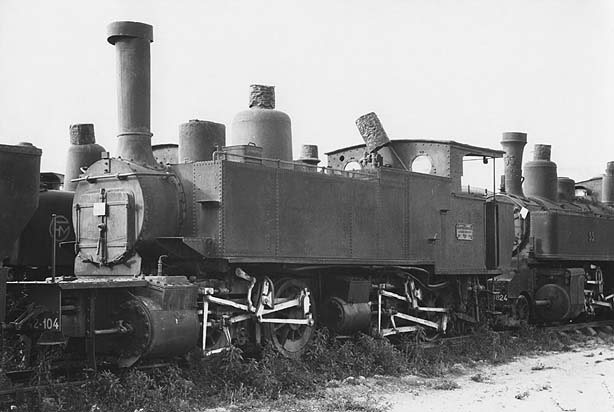
Mocambique
Two South African Mallets ended their
working lives based at Moatize, where they have survived ever since.
They were already derelict in 1968 when Basil Roberts took this picture,
however, amazingly they are still there and ambitious plans exist to
repatriate and maybe restore (one of) them. This is 2-6-6-0 101 (Alco 50847/1912): 
Americas
While the Mallet - in both traditional
compound and also simple forms - was widely used in North America, it was
not greatly used in South America where Garratts and particularly Kitson-Meyers
were preferred.
Brazil
The Donna Theresa Christina Railway (EFDTC)
had 5 2-6-6-2 simple Mallets from Baldwin which were the last active
examples in South America. James Waite photographed 203 stored at Tubarao depot in September 1977
(204 was also present). Both these survive in preservation (203 at
Tubarao and 204 at Rio Negrinho) but neither is anything like in working order. 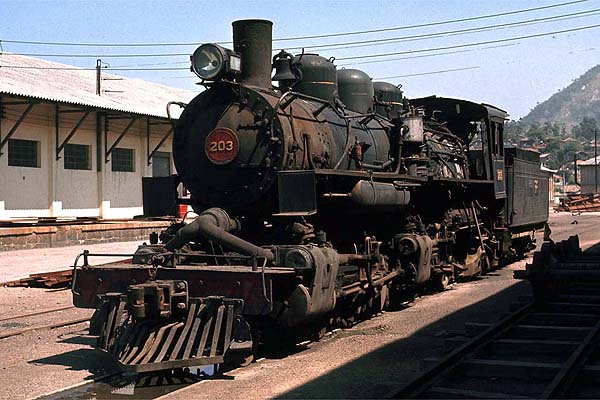
USA
2014 has seen the restoration commence on
two giants ot the steam age (added 8th May 2014). There will be regular
updates on the web no doubt, easily found using your favourite search
engine:
Thomas Schultz comments: Here in North America, only a handful of Mallet locomotives are serviceable:
Union Pacific Railroad 3985, 4-6-6-4
(out of action since 2010): Black Hills Central Railroad 110,
2-6-6-2ST (Balldwin 60561/1928):
http://www.1880train.com/
(Trevor Heath picture, 22nd September 2017) 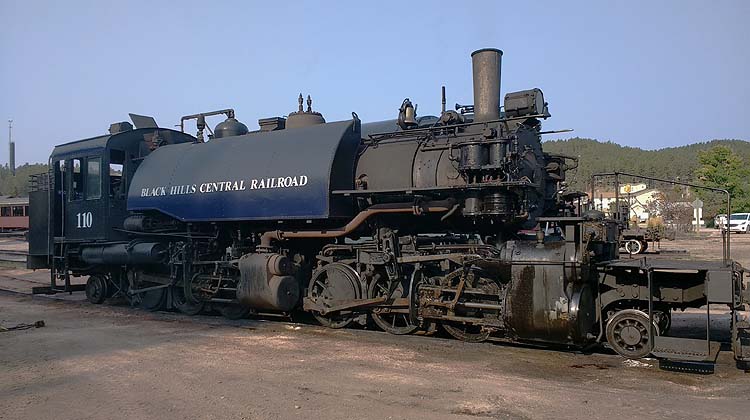
Clover Valley Lumber Co. 4,
2-6-6-2ST (Baldwin 57684/1924): http://plasteam.ncry.org/CVL4/index4.htm
(Martin E. Hansen's picture)
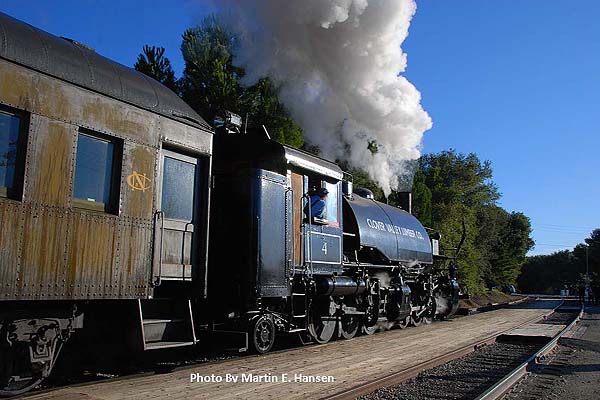
The Cripple Creek
and Victor Railroad in Colorado has an Orenstein and Koppel
Mallet(2707/1908) which was brought up from the Avalos Zacetactus mines in
Mexico, it is said to run during July and August while the other two
conventional locomotives run most of the services. This picture comes
from Trevor Heath (22nd September 2017). Sister engine OK 6024/1912 is
preserved at Saltillo, Mexico)
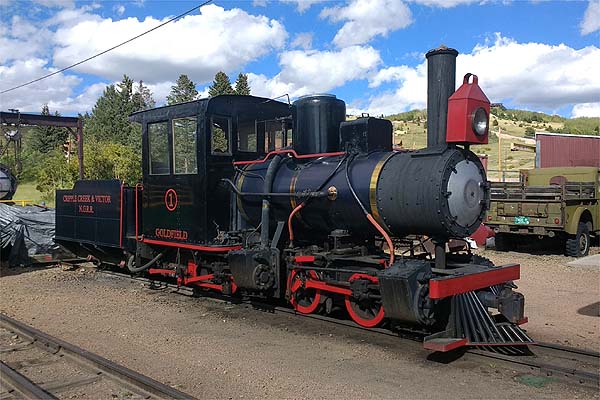
Mallet under repair:
Little River Railroad 126, 2-4-4-2:
http://loggingmallets.railfan.net/list/lr126/littleriver126.htm
Mallet withdrawn from excursion service:
Norfolk & Western Railway 1218, 2-6-6-4:
http://vmt.org/
Numerous Mallet locomotives are preserved, not serviceable.
Asia
Indonesia
As the country which was the last to operate
significant numbers of Mallets large and small, it deserves a special
section. These I have placed on separate pages, they are now historical in
the sense that the number of active Mallets is tiny, but many of these
locomotives survive stored in sugar mills and others in static preservation.
At least five have been exported including Pakis Baru #5 which is now in the
UK

Indonesian
Narrow Gauge Mallets on Video (added 25th December 2013)
Indonesian Narrow Gauge Mallets - Java
Indonesian Narrow Gauge Mallets -
Sumatra Indonesian
Mallets - Main Line
Philippines
The Insular Limber Company on Negros Island
used Baldwin 0-6-6-0 compound Mallet (58239/1925) on its 1067mm (3'
6") gauge line and it was photographed by Basil Roberts at Fabrica in 1973.
It is now preserved, nearby in Sagay City. 
Syria
Hartman 0-4-4-2T 962 is one of two supplied
by Hartmann in 1906. It was photographed by Roland Beier at Muzerib and in the Yarmuk Gorge on an
enthusiasts' special in May 2004. More recently it has been reported
running on what remains of the Damascus to Beirut line, its original home.
None of the Henschel Mallets delivered here is likely to run again. 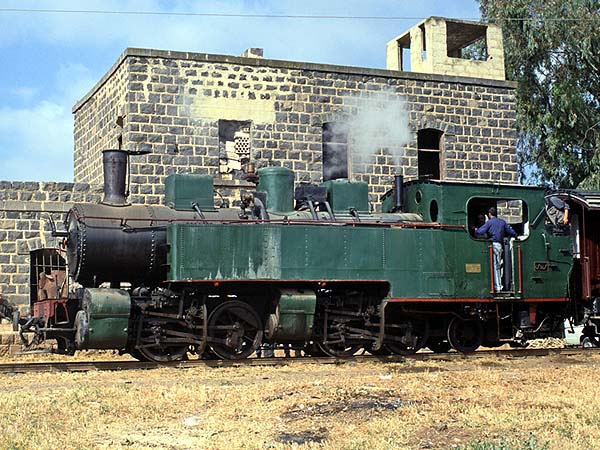

Australasia
Australia
One of only three Mallets supplied to Australia, former
Magnet Tramway 3 in Tasmania (OK
2609/1907) is under slow restoration at the Bennett Brook Railway in Western Australia,
currently awaiting funds for completion. See - http://www.bennettbrookrailway.org/o&k_mallet.htm
(link broken by April 2015).
Unusually it has the rear (high pressure) cylinders at the outside instead
of the middle. This is Michael Watson's picture taken on 1st November
2009.
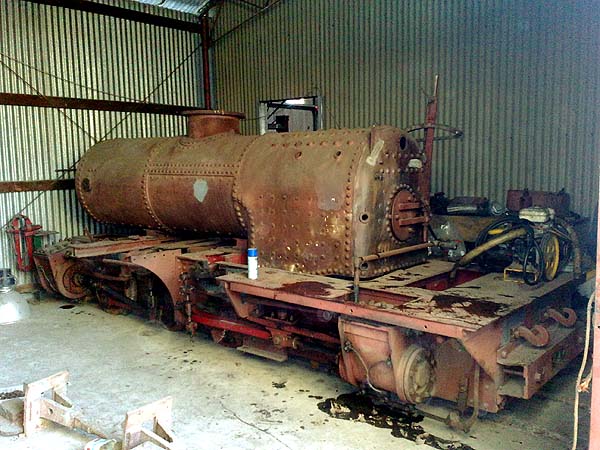
New Zealand
Some years back the Glenbook Vintage Railway near
Auckland, North Island restored this 1912 Alco 2-4-4-2 from the Totara
Timber Company - the only Mallet locomotive in the country. By the time I
got there in 2002 it was stored in good condition awaiting boiler repairs.

Europe
Mallets were found all over Europe although,
perhaps surprisingly they never caught on in France beyond the narrow gauge.
This is a short survey of those survivors I know about. For German
language information see http://www.malletlok.de/ - link found broken on 27th October 2017.
Czech Republic
The JHMD narrow gauge line has U47.001 which is a
Henschel 0-4-4-0 Mallet tank. See James
Waite's report of an August 2008 visit.

Roland Beir photographed it at work on 31st
August 1996.
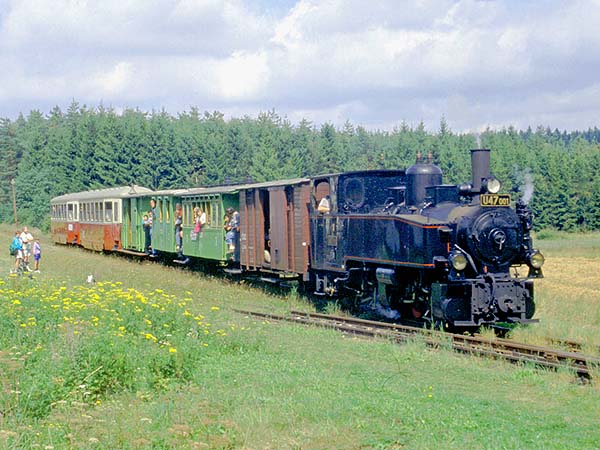
France
The Vivarais metre gauge line, now alas
with service 'suspended' has a fine fleet of Mallets. James Waite has sent
a small set of pictures from 1991, we would welcome more:

Former CP E-211 is on the Chemin de Fer de la
Provence. It has not run for some time, but is under active repair..
See this page for a list of extant Mallets
in France - http://www.malletlok.de/ge/ge_fr/ge_fr.HTM
(German language, link found broken on 27th October 2017.
Germany
By Durrant's reckoning 'the major user of
Mallets in Europe' but there is little residual evidence of that today.
The Harzer Schmalspurbahnen (HSB) which tend
to be used on special occasions. James Waite has sent some
pictures from the 1970s when they worked most of the trains out of
Gernrode.
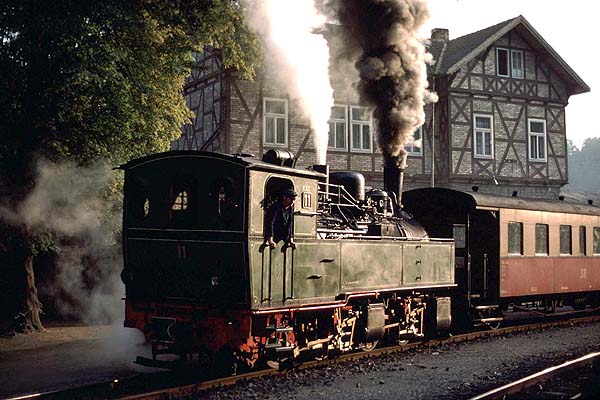
The Bruchhausen-Vilsen to Asendorf Railway
has 0-4-4-0 Mallet tank “Mallet” (Karlsruhe 1478/1897) which is
currently under restoration.
The Frankfurter Feldbahn Museum has
former Gending 4 from Java, Indonesia - see James
Waite's report of its centenary celebrations in June 2009.

See this page for a list of extant Mallets in
Germany - http://www.malletlok.de/ge/heute_d/heut_tab.HTM
(German language, link found broken on 27th October 2017)
Italy
FCS 0-4-4-0 Mallet tank no. 202 of
unconfirmed provenance survives outside the Monserrato Railway Museum, Sardinia
(James Waite photograph)
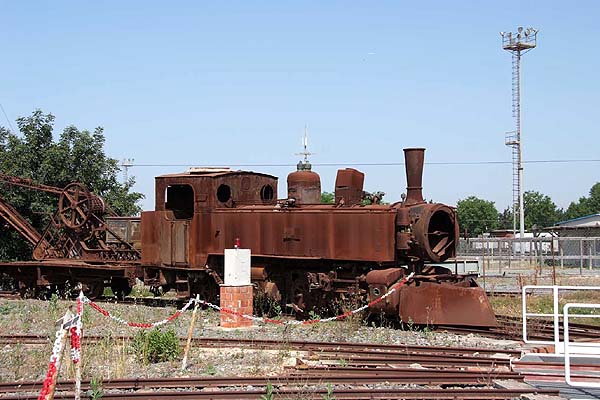
Montenegro
This 2-4-4-0T Mallet is at Bar station - see James
Waite's report of a September 2008 visit.

Portugal
The metre gauge railways here were the
last major Mallet operated steam railways in Europe. The Mallets came in
three batches; two 0-4-4-0T were originally 900mm gauge and were later
converted, there were more of the same wheel arrangement but larger and
finally still larger 2-4-6-0T. James Waite has provided a pen portrait
of his visits in the years before steam finished. Enjoy - there is
more like this to come!

Part 1 - The Regua Line
Part 2 - The Tua Line
Part 3 - The Tabor Line
Two of these locomotives are now in
Switzerland see http://www.la-traction.ch
and another in France - Chemin de Fer de la
Provence. It has not run for some time, but is under active repair see http://www.gecp.asso.fr/
(link broken by December 2021).
See this page for a list of extant
Mallets in Portugal - http://www.malletlok.de/ge/heute_p/heute_p.HTM
(German language, link found broken on 27th October 2017).
Serbia
JZ 92 043 2-6-6-0 Mallet, 760mm gauge,
Henschel works no. 19472 of 1922 is preserved at Pozega Railway Museum,
Serbia, see James
Waite's report of a 2005 visit. The former Yugoslavia ranked
foremost in Europe in its use of Mallets according to Durrant's book
(but he also says that Germany was the major user in terms of quantity -
I think this was correct!). They were many and varied but I fear few
survive today.
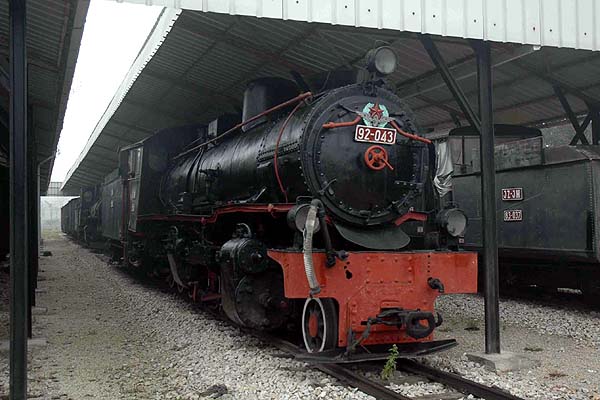
Sweden
While not many Mallets were built or
delivered to the country, a significant proportion have been preserved.
The Östra Södermanlands Järnväg (ÖSlJ) has two Mallets, you can
read James
Waite's report of a 2009 visit. One is a fairly 'common' OK, but
their star is “Lessebo” a classic Decauville type, built in 1891
and the oldest operable Mallet in the world.

Two more Mallets are preserved on Jädraås–Tallås Järnväg
(JTJ), you can read James
Waite's report of a 2009 visit. Both were built by Atlas in Stockholm in
1910.
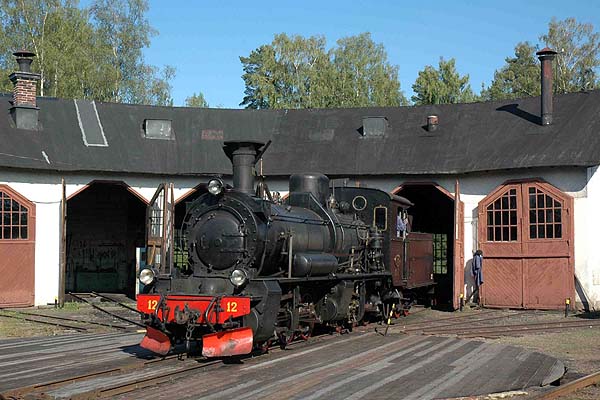
Switzerland
There is an active indigenous Mallet, Maffei
built former SCB 196, said to be the only serviceable standard gauge Mallet
in Western Europe. It is based at Balsthal on the Oensingen - Balsthal Bahn (OeBB), a local railway in the canton of
Solothurn. See http://www.markusworldwide.ch/Railways/Steam/Switzerland/DVZO/DVZO_GalleryPage2.htm. Two
more Mallets are based on the metre gauge Blonay - Chamby line, see http://www.blonay-chamby.ch/
and http://en.wikipedia.org/wiki/Blonay%E2%80%93Chamby.
Former CP metre gauge Mallets 0-4-4-0T (E164) and a 2- 4- 6- 0T
(E206) are now on the CF de Jura and in full working order - see under
Portugal for more information on them. See http://www.la-traction.ch.
|
|




























